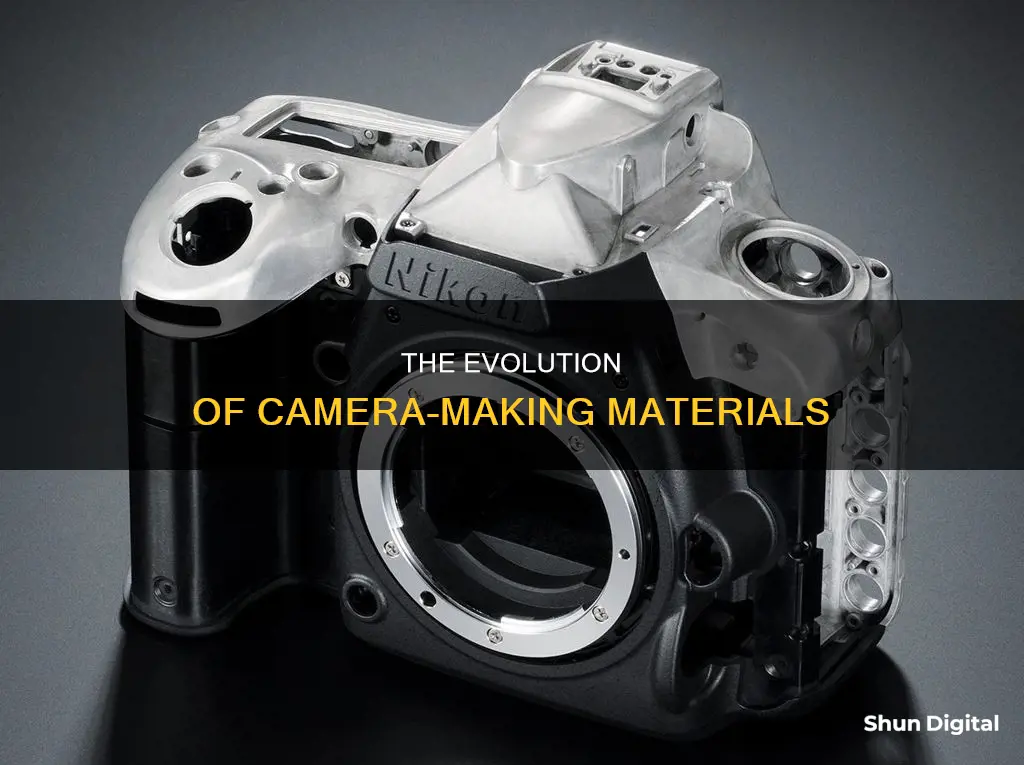
Cameras are made of a variety of materials, with the most common being plastic and metal. The type of material used depends on the camera's design and purpose. For instance, higher-end film cameras often feature metal frames for ruggedness and longevity, while plastic is used for more structural components in digital cameras. The camera lens, which is typically made of glass, plays a crucial role in focusing light onto the camera's film or digital sensor to produce an image. Other materials used in camera construction include glass-filled polycarbonate, aluminium, rubber, and various electronic components.
| Characteristics | Values |
|---|---|
| Lens | Glass or plastic |
| Diaphragm | Fixed lens, adjustable aperture |
| Shutter | Metal leaves |
| Camera body | Polycarbonate compound with glass fiber, lightproof, durable, shock-resistant, and tolerant to humidity and temperature changes |
| Viewfinder | Optical glass, plastic, or glass/plastic combinations |
| LCD screen | Liquid crystal display |
| Electronics | Integrated circuitry |
What You'll Learn

Camera bodies are made of polycarbonate, glass-filled polycarbonate, or engineering-grade plastic
Polycarbonate is a type of engineering plastic that is often used in devices designed for extended outdoor use. It is known for its durability and impact resistance, making it a suitable material for camera bodies. When a polycarbonate camera body falls or strikes a hard surface, the shell can flex, slowing down the impact and reducing potential damage to the camera's internal components.
Glass-filled polycarbonate is a composite material that combines the benefits of both glass and polycarbonate. The addition of glass improves the impact, moisture, and chemical resistance of the polycarbonate. Canon was a pioneer in the use of glass-filled polycarbonate in camera bodies, first utilising the material during the film era for lens barrels and other non-optical components.
Engineering-grade plastics, such as Nylon 6-6 or Ultra-high-molecular-weight polyethylene, are also used in camera bodies. These plastics are combined with other materials to create rugged composites that offer strength and protection.
The choice between polycarbonate, glass-filled polycarbonate, and engineering-grade plastic depends on various factors, including cost, weight, and the desired features of the camera. Each material has its advantages, and engineers carefully select the most suitable option for a particular camera model.
The Rebel T6 Camera Battery: How Long Does It Last?
You may want to see also

Lenses are made of glass or plastic
Glass lenses are responsible for bending and focusing light onto the camera sensor. Optical glass is specifically designed for clarity and minimal distortion. Different types of glass, such as low-dispersion and aspherical glass, are often combined in complex arrangements to correct for various optical aberrations and enhance image quality.
Plastics allow for the manufacturing of strongly aspherical lens elements, which are difficult or impossible to manufacture in glass. They simplify or improve lens manufacturing and performance and are not limited to cheaper lenses. Many modern, high-performance (and high-priced) lenses from popular manufacturers include moulded or hybrid aspherical elements.
Glass and plastic are not the only materials used for lenses. Other materials include quartz glass, fluorite, and even germanium and meteoritic glass.
The Evolution of Camera Lenses: Glass and Beyond
You may want to see also

Cameras contain metal parts
The type of metal used in camera bodies has varied over time. Early cameras used brass and stainless steel, while more modern cameras may use aluminium, steel, or magnesium for their frames. Some cameras may also have a metal skeleton with a plastic exterior.
Metal is valued in camera construction for its strength, durability, and ability to dissipate heat. It is also easily machinable, making it suitable for the creation of small screws and tapped holes. Additionally, metal is recyclable, which can help reduce electronic waste and conserve resources.
While metal has been a traditional choice for camera bodies, the use of plastics and composite materials has become more common, even in higher-end cameras. This shift may be due to the impact-absorbing capabilities of composites, which can protect sensitive electronic components. Additionally, composites can be engineered to be exceptionally strong and dimensionally stable, making them competitive with metals in terms of strength and durability.
In summary, cameras do contain metal parts, and metal has been a traditional material of choice for camera construction. However, the use of plastics and composites has increased as these materials offer their own advantages in terms of strength, durability, and impact protection. The choice of materials ultimately depends on the specific design requirements and trade-offs between different materials' properties.
Understanding Program Mode: Camera's Auto-Adjusting Setting
You may want to see also

Cameras are made of recyclable materials
Cameras are made of a variety of materials, some of which are recyclable. The camera chassis or body is typically made of a polycarbonate compound, which is durable, lightweight, shock-resistant, and tolerant of humidity and temperature changes. This material can be recycled, although it is not resistant to chemicals. The lens of a camera is usually made of glass or plastic, or a combination of both, and can be recycled. The remaining parts of a camera are incorporated into the camera body and include the shutter, film transport system, light meter, built-in flash, reflex viewing system, and various electronic and mechanical components. These parts are made of plastic, metal, glass, circuit boards, and rubber, all of which are recyclable.
When recycled, cameras are dismantled, and their components are separated and sorted into different material categories for further processing. The recyclable materials from cameras can be used to produce new products, such as new cameras, toys, and furniture. This reduces the need for mining and extracting new metals and parts, conserving resources and reducing environmental impacts.
It is important to recycle cameras properly to prevent harmful substances, such as lead, mercury, cadmium, and arsenic, from contaminating the soil and water. By recycling cameras, individuals can reduce their carbon footprint, support environmental organizations, and create economic opportunities.
Alkaline Batteries: How Long Will Your Camera Run?
You may want to see also

Cameras are electronic waste
Cameras are considered electronic waste (or e-waste). This includes digital cameras, as well as non-digital cameras such as film cameras. E-waste is a growing concern, as it affects the environment in many ways. Hazardous components of electronic devices, such as cameras, contain toxic elements such as lead, mercury, cadmium, and arsenic. These substances can contaminate soil and water when improperly disposed of or left in landfills.
Digital cameras are durable and seldom fail, but they are frequently replaced as consumers seek the latest technology. This results in a large number of cameras being discarded, contributing to the growing problem of e-waste.
The good news is that most cameras can be recycled, and many camera recycling programs accept all makes and models. Recycling cameras can help reduce your carbon footprint, conserve resources, and support organizations dedicated to protecting the environment. It also ensures that valuable materials from cameras are not wasted, reducing the need for mining and extracting new metals and parts.
When a camera is recycled, it is typically dismantled, and its components are separated and sorted into different material categories for further processing. The plastic casing, lens, glass, and metal parts, such as screws and circuit boards, can be recycled and used to produce new products.
Proper disposal of cameras as e-waste is crucial to minimizing the environmental impact of this increasingly common form of waste.
Camera Battery Swap: Is It Safe?
You may want to see also
Frequently asked questions
Camera bodies are typically made of metal or composite materials. Metal was more commonly used in the past, but modern cameras tend to use composite materials for structural components, while still containing some metal parts.
Aluminium, steel, and magnesium are all used in camera bodies. Aluminium is light and easy to machine, but it deforms under repeated stress. Steel is stiffer and stronger than aluminium but is heavier. Magnesium is strong, stiff, and lightweight, but it is covered in plastic because it is difficult to machine.
Composites used in camera bodies include glass-filled polycarbonate, engineering-grade plastics such as Nylon 6-6 or Ultra-high-molecular-weight polyethylene, and carbon fibre.
Camera lenses are typically made of glass, or sometimes plastic or a combination of the two.







